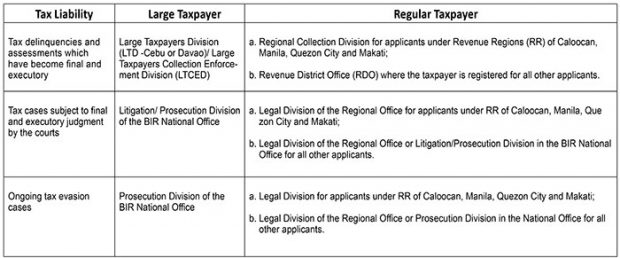Amnesty for tax delinquents
In our previous articles, we’ve discussed Republic Act (RA)–1213, the “Tax Amnesty Act of 2019” (Tax Amnesty Act), particularly the fact that President Duterte vetoed several provisions, specifically the General Tax Amnesty (GTA). The GTA was supposed to cover all national internal revenue taxes (i.e., income tax, withholding tax, value-added tax, etc.), with or without assessments, that have remained unpaid as of Dec. 31, 2017.
With the veto of the GTA, the Tax Amnesty Act is left with the remaining two separate tax amnesty programs: Estate Tax Amnesty and a Tax Amnesty on Delinquencies (TAD).
Quite recently, the Department of Finance (DoF) and the Bureau of Internal Revenue (BIR) issued the implementing rules and regulations (IRR) for the TAD, Revenue Regulations (RR) 4-2019, which was published on April 9, 2019. The regulations take effect 15 days from the date of its publication, which will be on April 24, 2019. The regulation’s date of effectivity is crucial, as the TAD may be availed of by taxpayers within one year from April 24, 2019.
Under the TAD, any person may enjoy the benefits and privileges of the tax amnesty by paying the following tax amnesty rates:
– 40 percent of the basic tax in cases of tax delinquencies and assessments which have become final and executory;
– 50 percent of the basic tax for cases subject to final and executory judgment by the courts;
– 60 percent of the basic tax for ongoing tax evasion cases; and
– 100 percent of the basic tax for withholding agents and their withholding tax liabilities.
In addition, the regulations provide for the following guidelines that taxpayers will have to follow in applying for the TAD:
Step 1 – Secure the Certificate of Delinquencies (Certificate) from the concerned BIR office as specified below:
For withholding agent-applicants concerning their withholding tax liabilities, a copy of the tax assessment found in the Final Assessment Notice/Final Decision on Disputed Assessment (FDDA) issued by the BIR will suffice, instead of the Certificate.
Step 2. Fill up the Tax Amnesty Return (TAR) and Acceptance Payment Form (APF), and have the APF endorsed by the RDO where the taxpayer is registered. For Large Taxpayers, the application is either filed with the LTD, or the LTCED. Upon endorsement of the APF, pay the tax amnesty amount with the appropriate BIR authorized agent bank.
Step 3. Upon payment, submit the TAR, APF, Certificate, and proof of payment of tax amnesty with the RDO/LTD/LTCED. Within 15 calendar days from submission of the APF and TAR, the BIR will provide a “Notice of Issuance of Authority to Cancel Assessment”. The TAD shall be considered fully complied with upon completion of the above enumerated steps.




